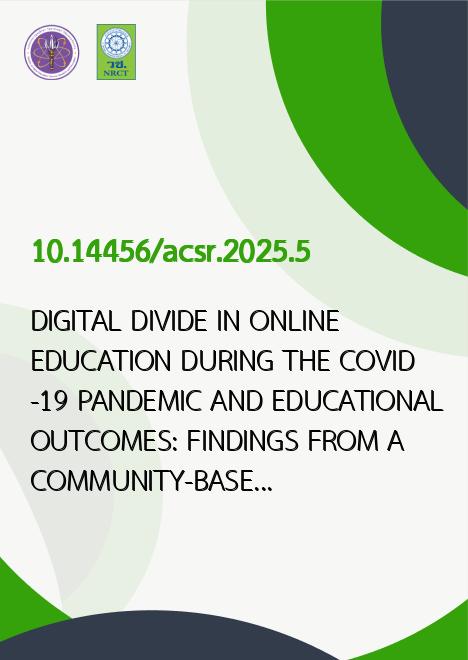
|
DIGITAL DIVIDE IN ONLINE EDUCATION DURING THE COVID-19 PANDEMIC AND EDUCATIONAL OUTCOMES: FINDINGS FROM A COMMUNITY-BASED SURVEY IN THAILAND'S IMPOVERISHED DEEP SOUTH |
|---|---|
| รหัสดีโอไอ | |
| Creator | Alisa HASAMOH |
| Title | DIGITAL DIVIDE IN ONLINE EDUCATION DURING THE COVID-19 PANDEMIC AND EDUCATIONAL OUTCOMES: FINDINGS FROM A COMMUNITY-BASED SURVEY IN THAILAND'S IMPOVERISHED DEEP SOUTH |
| Contributor | Sasamon SRIVIRAT, Wit WICHAIDIT |
| Publisher | Asian Crime and Society Review |
| Publication Year | 2568 |
| Journal Title | Asian Crime and Society Review |
| Journal Vol. | 12 |
| Journal No. | 1 |
| Page no. | Article 5 |
| Keyword | Education, Dropout, Digital Divide, Latent Class Analysis, COVID-19 |
| URL Website | https://so02.tci-thaijo.org/index.php/IJCLSI |
| Website title | https://so02.tci-thaijo.org/index.php/IJCLSI/article/view/274842 |
| ISSN | 3027-6896 |
| Abstract | Data about the extent to which digital divides in online schooling during the COVID-19 pandemic were associated with dropouts from the education system are scarce. This study aims to assess the extent to which digital divides during the pandemic were associated with 1) School drop-out and 2) the Outlook of secondary education completion. We interviewed school-going adolescents aged 13-18 years (n = 643) and caregivers of school-going children aged 7-12 years (n = 663), categorized patterns of the digital divide. We analyzed the study data using descriptive statistics and multivariate logistic regression. We also conducted focus group discussions with education stakeholders. We found significant associations between experience of severe (vs. low) levels of digital divide and dropouts among the children (81% vs. 46%) and among adolescents (14% vs. 2%). Still, we found no significant association with the outlook of secondary education completion. The study findings provide potentially helpful basic information for stakeholders. However, caveats regarding the study design, potential information biases, and discrepancies in selecting quantitative and qualitative study participants should be considered caveats in interpreting the study findings. |
